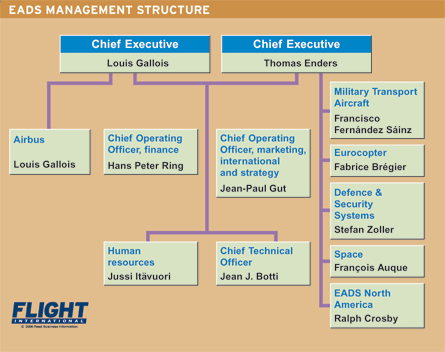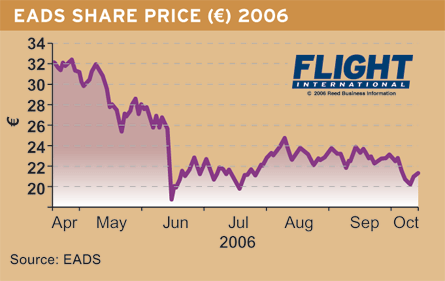New Airbus chief represents a tighter EADS grip on its errant airframer, but he faces the same dilemmas as Streiff
Anyone who expects Louis Gallois to be a soft touch at Airbus after the whirlwind reign of Christian Streiff may be in for a shock. The avuncular 62-year-old - who added direct responsibility for the airframer to the EADS co-chief executive role he took on in July after Streiff's sudden resignation last week - may have a background in the more consensual world of the civil service and state-run industry but most observers expect him to push through Streiff's planned cost-cutting measures with the backing of shareholders.
Who is he?● Louis Gallois was born in 1944 in south-west France ● Like most French captains of industry, he is a graduate of the Ecole Nationale d'Administration ● He spent his early career in various government ministries ● He was chief executive of Snecma from 1989 to 1992 ●From 1992 to 1996, he ran EADS predecessor Aerospatiale ● His last full-time job was president of French railway operator SNCF ● He has been an EADS director since 2000 |
|---|
The big difference from Streiff will be in terms of style and background. Streiff was hand-picked as chief executive of Airbus just four months ago because he was an outsider. When Gallois's predecessor Noël Forgeard and Airbus chief executive Gustav Humbert resigned before Farnborough (when the extent of the A380 crisis became clear), EADS bosses wanted to bring in a proven leader with no industrial or political baggage. In the former chief operating officer of Saint-Gobain - a Frenchman who had worked in Germany and spoke fluent German - they thought they had found a true European who could bridge the cultural divide, analyse the problem with fresh eyes, and administer the tough medicine needed to get the airframer back to health.
But Streiff almost certainly misjudged the scale of the task: not only sorting out the industrial mess, but dealing with Airbus's and EADS's powerful stakeholders - French and German politicians, the private sector shareholders represented by EADS co-chairmen Arnaud Lagardère of the French media group and DaimlerChrysler's Manfred Bischoff, and the unions. Gallois, by contrast, has long experience of playing the political game. "He is very, very politically astute. He understands how to handle the unions," says one London-based analyst. "He has a reputation for taking tough decisions sensibly."
Streiff "didn't have that nuanced approach", he says, and was much more "macho and capitalist".
Streiff's biggest mistake was to insist on having the freedom to do what he wanted at Airbus without the EADS board breathing down his neck. This was never going to happen, given that the autonomy awarded to Forgeard - both as Airbus CEO, and later when he took responsibility for the airframer at EADS - meant that EADS shareholders were not aware of the A380 crisis until it was too late.
EADS wanted a tough guy to crack heads together at Toulouse, Hamburg and the other plants, but one firmly under the watchful eye of Paris and Munich, head offices that do not always see eye to eye.
In an interview with French financial newspaper Le Figaro just after he resigned, Streiff bemoaned the EADS managing culture, calling it "a system of balancing forces that undermines itself with duplications and is cumbersome", more concerned with "the delicate balancing of people, of power and of positions" than running an effective business. This formula, he said, worked when Airbus was prospering. But "for a company going through a serious crisis", it was no longer appropriate.

But EADS co-chairman Bischoff hit back in an interview he gave last week to another French newspaper, Les Echos. "[Streiff] complained about the degree of integration of Airbus into EADS," he said. "However, the board of EADS had clearly indicated its wish to have more visibility at Airbus after the problems with the A380. One of the main causes of the problems was the board's lack of visibility at Airbus. We gave a lot of autonomy to Forgeard and the result was a slip of €5 billion [$6 billion] on the A380 programme."

The problem, according to one analyst, is that Streiff did not realise that "Airbus is a subsidiary of EADS, not the other way round. Streiff wanted autonomy." Given the mire that the other chief executives got Airbus into, that was never going to be accepted, he says.
The contrast between Airbus and Boeing is marked. While commercial aircraft represent 41% of Boeing's sales, against 64.9% for EADS, Boeing has a conventional corporate structure, where the chief executive of Boeing Commercial Airplanes in Seattle, along with the heads of other Boeing divisions, reports to the CEO of Boeing in Chicago.
After its short-lived trial of going outside the industry for its saviour, EADS now seems content to stick with aerospace experience and move Airbus firmly within the control of the EADS board - a decision made easier by BAE shareholders ' overwhelming acceptance earlier this month of EADS's £1.9 billion offer for the company's 20% share in the airframer.
Although Gallois is a steady pair of hands, he may find himself running Airbus for the remainder of his contract, which ends in 2010. "Gallois knows the industry inside out," says the same analyst. "He's been a supplier and an engine manufacturer, and has a rounded view of what Airbus is like."
He will certainly have his hands full. Despite a shuffle of reporting lines which will see his German counterpart Tom Enders take responsibility for all of EADS's other business divisions (see chart), Gallois must share EADS executive board duties with hands-on responsibility for Airbus, and will split his time between EADS's French headquarters in Paris and Airbus in Toulouse. Given that Streiff vowed to work 20h days to sort Airbus's problems out, the scale of Gallois's task becomes clear. The fact that several senior Airbus veterans of the Forgeard era have resigned or been sidelined in the last 18 months - including former chief operating officer Humbert, A380 programme head Charles Champion and former operations chief Gérard Blanc, who left shortly after Humbert's appointment - means that Gallois has a shortage of experienced managers to turn to.
This means that Gallois will have to appoint a chief operating officer (COO) to steer through the industrial changes needed and ensure the A380 meets its latest revised certification schedule. This is the role that Humbert had under Forgeard, and which Champion assumed - alongside chief salesman John Leahy - when Humbert moved up to become chief executive. Airbus says the appointment of a COO "who will work very closely" with Gallois is likely to take place in the "not too distant future".
Whether this will be someone from inside the organisation or not is uncertain. After the departure of so many senior figures from Toulouse, Gallois may have to turn for experience to one of Airbus's sister businesses within EADS.
Airbus and EADS last week moved to assure the financial community that Streiff's plan to cut €2.1 billion a year in costs, known as "Power8", remains in place, although full details are not expected to be announced until January. Around 42% of EADS shares are traded, and investors seem to be content with that intention and Gallois's appointment, actually sending the EADS share price up following Streiff's departure (see graph).
Some analysts even believe that Gallois may go further than Streiff down the cost-cutting road. "Streiff's resignation is unlikely to impact Power8, other than a slight delay in initiation," says Michael Richter, co-president and head of aerospace and defence at investment bank Jefferies Quarterdeck. "Power8 is critical to Airbus's long-term market position. While recent results have been good - notwithstanding A380 - much of this is masked by dollar hedging, and long-term competitiveness in a weak dollar market requires significant cost-base reduction."
This is the sort of language, however, that sends unions and politicians into a frenzy. For a company which has consistently grown since its formation in 1970 and which represents the aerospace pride of three, if not four, European nations, the prospect of job cuts and factory downsizing is a new one. Thanks to its large orderbook and tight employment laws, Airbus avoided the mass redundancies that its rival Boeing was forced into after 9/11.
Now, many observers believe that moving design and production to the most cost-effective location, and ditching the careful balance of workshare between home nations, may be the only way forward, even if it means taking tough political decisions. And measures may have to be taken as early as the next few years, when responsibility for the A350XWB is allocated, including moving key production work outside Western Europe.
"Without serious structural reform, measures like Power8 are like running just to stay in place," according to Richard Aboulafia, vice-president analysis of Teal Group in New York. "They need to cut costs to deal with the currency problem. But a far more serious long-term consideration is changing the way they do business to enable the A350's launch.
"They need to be able to sign international partnerships and move work to the most efficient site, without any political considerations getting in the way. Without this freedom, the A350 will be very difficult to execute and Airbus risks marginalisation within five years. Power8 does not address this pressing need."

Source: Flight International























